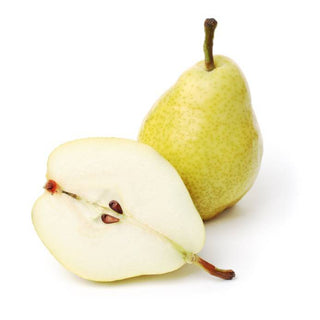(Pyrus communis)
Pears are members of the rose family and are related to the apple and the quince. Pears are juicy and sweet, with a soft, buttery yet somewhat grainy texture. This soft texture is the result of the starch converting to sugar after being picked from the tree to ripen. Depending on the variety of pear, its paper-thin skin can either be yellow, green, brown, red or a combination of two or more of these colors.
Although more than 3,000 known varieties are known, the Bosc, Bartlett, Anjou, and Comice pears are the most commonly available types in the United States. Varieties such as Conference, Passe Crassane, and Packham, which are popular in other countries, are also becoming more available.
Crowned the “gift of the gods” by the ancient Greeks and cultivated by the Romans (who refused to eat them raw), pears came to America practically on the Mayflower. The first pear tree was planted in the United States in 1620 and these cold hearty fruits could have been served at the very first Thanksgiving! Americans still hold a fondness for this early fruit – pears rank second only to apples as the most popular fruit in the United States.
Today, U.S. production comes from states in the Northwest, plus New York, Pennsylvania, Michigan, and California. Imports come from South America, Canada, New Zealand, and South Africa.
Nutrition and Health Benefits
A medium sized pear contains 103 calories and offers a natural, quick source of energy, due largely to high amounts of two monosaccharides: fructose and glucose. In addition, levulose, the sweetest of known natural sugars, is found in larger quantities in fresh pears than in any other fruit. Pears are also a good source of fiber, with a medium pear providing 6 grams or 22% of daily values.
A medium pear provides 212 mg of potassium or 6% of daily values. This fruit is also a good source of vitamin C, providing 12% of daily values.
As with most fruits and vegetables, fully ripened pears have a higher concentration of antioxidants. Additionally, antioxidants are more concentrated in the skin, especially the varieties with the deeper colored red or russet skins.
Selection and Storage
Because they are very perishable once they ripen, pears found at your grocer will usually be unripe and require a few days to mature. Select pears that are firm, but not too hard. The skin should be smooth, free of bruises, mold, punctures and dark soft spots. Some pears feature russetting (brown speckled patches on the skin). This is perfectly acceptable and often reflects a more intense flavor.
A little known fact about the pear is that it is one of the few fruits that does not ripen on the tree. Most varieties show little change in color as it ripens. Pears ripen from the inside out. The best way to judge ripeness is to “check the neck”. Gently apply thumb pressure to the neck or stem end of the pear. Once the skin yields to soft pressure, the pear is ripe and ready to be eaten.
Pears should be left at room temperature to ripen. Once ripened, pears will remain fresh for a few days if stored in the refrigerator. To hasten the ripening process, place the pears in a paper bag at room temperature. Storing pears in plastic bags or restricted spaces should be avoided. The limited exposure to oxygen greatly increases the ripening process and degradation of the fruit.
For optimal taste, pears should be stored away from other strong smelling food, as they tend to readily absorb smells.
Recipes and Preparation
One of the United States’ most popular varieties of pear, the Bartlett, is in season July through November, so make sure to include this delicious treat in your holiday meal.
When it comes to pears, the possibilities are endless. Fresh pears are delicious eaten as is after gently washing the skin by running it under cool water and patting it dry. Combine pears with mustard greens, watercress, leeks and walnuts for a delicious salad. Serve pears with goat or bleu cheese for a wonderful dessert. For another dessert option, core pears and poach in apple juice or wine. If planning to bake pears, choose pears that are fairly firm.
For some great, healthy pear recipes, visit the Northwest Pear Growers’ website or FitSugar.
Fun Facts
Because pears are less allergenic than many other fruits, pear juice is sometimes used as the first juice introduced to infants.

